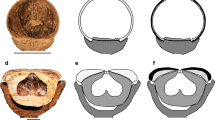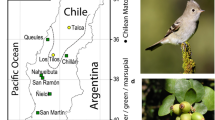Summary
We investigated inter-specific variation in fruit characteristics — fruit size, seed number per fruit, seed weight, nutritional content, fruit persistence, and fruit synchronization — in relation to flowering and fruiting phenology in 34 species of fleshy fruited plants. Except for aspects of fruit synchrony and persistence, the results in general were inconsistent with previous suggestions about adaptive variation in phenologically related fruit traits. The main results were as follows: (1) Late flowering, late fruiting, lengthy development time from flower to fruit, and highly persistent fruits constitute a complex of correlated characteristics among the species. (2) Synchronization of fruiting within individuals increased from early ripening fruits to late ripening fruits. Fruiting synchrony was more pronounced in species with a small crop size than in species with a large fruit crop, whereas synchrony was not significantly related to flowering synchronization, nor to life form. (3) Nitrogen and carbohydrate content of fruit pulp did not vary in relation to phenology, whereas lipid content decreased from early to late ripening fruits. (4) No seasonal trends were found for variation in seed size or seed number per fruit. (5) Interactions with flowering phenology and developmental constraints are important in phenological fruiting patterns. Temporal variation in start of fruiting was partly (36%) explained by variation in flowering time. Seed weight variation explained 17% of variation in development time from flower to fruit. (6) Despite constraints from flowering and seed development, some adaptive adjustment in fruiting phenology is likely to be allowed for among the investigated species. Such an adaptive variation in fruiting phenology was suggested by intra-generic comparisons of Prunus and Vaccinium species.
Similar content being viewed by others
References
Bremer B, Eriksson O (1991) Evolution of fruit characters and dispersal modes in the tropical family Rubiaceae. Biol J Linn Soc (in press)
Buchholz R, Levey DJ (1990) The evolutionary triad of microbes, fruits, and seed dispersers: an experiment in fruit choice by cedar waxwings, Bombycilla cedrorum. Oikos 59:200–204
Debussche M (1988) La diversité morphologique des fruits charnus en Languedoc méditerranéen: relations avec les caractéristiques biologiques et la distribution des plantes, et avec les disséminateurs. Acta Oecologica, Oecol Gener 9:37–52
Debussche M, Isenmann P (1989) Fleshy fruit characters and the choices of bird and mammal seed dispersers in a Mediterranean region. Oikos 56:327–338
Debussche M, Cortez J, Rimbault I (1987) Variation in fleshy fruit composition in the Mediterranean region: the importance of ripening season, life-form, fruit type and geographical distribution. Oikos 49:244–252
Estrada A Fleming TH (1986) (Eds) Frugivores and seed dispersal. Dr W Junk Publ, Dordrecht
Gorchov DL (1987) Sequence of fruit ripening in bird-dispersed plants: consistency among years. Ecology 68:223–225
Gorchov DL (1988) Does asynchronous fruit ripening avoid satiation of seed dispersers?: A field test. Ecology 69:1545–1551
Gorchov DL (1990) Pattern, adaptation, and constraint in fruiting synchrony within vertebrate-dispersed woody plants. Oikos 58:169–180
Granström A (1986) Seed banks in forest soils and their role in vegetation succession after disturbance. Ph D Thesis. Swedish University of Agricultural Science (Dept of Forest Site Res) 6.
Herrera CM (1982a) Seasonal variation in the quality of fruits and diffuse coevolution between plants and avian dispersers. Ecology 63:773–785
Herrera CM (1982b) Defense of ripe fruit from pests: its significance in relation to plant disperser interactions. Am Nat 120:218–241
Herrera CM (1984a) A study of avian frugivores, bird-dispersed plants, and their interaction in mediterranean scrublands. Ecol Monogr 54:1–23
Herrera CM (1984b) Avian interference of insect frugivory: an exploration into the plant-bird-fruit pest evolutionary triad. Oikos 42:203–210
Herrera CM (1986) Vertebrate dispersed plants: why they don't behave the way they should. in: A Estrada, Fleming TH (eds) Frugivores and seed dispersal. Dr W Junk Publ, Dordrecht, pp 5–18
Howe HF (1986) Seed dispersal by fruit-eating birds and mammals. In: DR Murray (ed) Seed dispersal. Academic Press, Sydney, pp 123–189
Howe HF, Smallwood J (1982) Ecology of seed dispersal. Ann Rev Ecol Syst 13:201–228
Johnson RA, Willson MF, Thompson JN, Bertin RI (1985) Nutritional values of wild fruits and consumption by migrant frugivorous birds. Ecology 66:819–827
Jones E, Wheelwright NT (1987) Seasonal changes in the fruits of Viburnum opulus, a fleshy fruited temperate-zone shrub. Can J Bot 65:2291–2296
Piper JK (1986) Seasonality of fruit characters and seed removal by birds. Oikos 46:303–310
Price MV, Jenkins SH (1986) Rodents as seed consumers and dispersers. in: DR Murray (ed) Seed dispersal. Academic Press, Sydney, pp 191–235
Primack RB (1987) Relationships among flowers, fruits, and seeds. Ann Rev Ecol Syst 18:409–430
Rathcke B (1988) Flowering phenologies in a shrub community: competition and constraints. J Ecol 76:975–994
Rathcke B, Lacey EP (1985) Phenological patterns of terrestrial plants. Ann Rev Ecol Syst 16:179–214
Skeate ST (1987) Interactions between birds and fruits in a northern Florida hammock community. Ecology 68:297–309
Snow DW (1971) Evolutionary aspects of fruit-eating by birds. Ibis 113:194–202
Snow B, Snow DW (1988) Birds and berries. A study of an ecological interaction. T & AD Poyser, Calton
Sorensen AE (1981) Interactions between birds and fruit in a temperate woodland. Oecologia 50:242–249
Sorensen AE (1984) Nutrition, energy and passage time: experiments with fruit preference in European blackbirds (Turdus merula). J Anim Ecol 53:545–557
Stapanian MA (1982) Evolution of fruiting strategies among fleshy-fruited plant species of eastern Kansas. Ecology 63:1422–1431
Stapanian MA (1986) Seed dispersal by birds and squirrels in the deciduous forests of the United States. In: Estrada A, Fleming TH (eds) Frugivores and seed dispersal. Dr W Junk Publ, Dordrecht, pp 225–236
Stebbins GL (1974) Flowering plants. Evolution above the species level. Belknap, Cambridge, Mass
Stiles EW (1980) Patterns of fruit presentation and seed dispersal in bird-disseminated woody plants in the eastern deciduous forest. Am Nat 116:670–688
Thompson JN, Willson MF (1979) Evolution of temperate fruit/bird interactions: phenological strategies. Evolution 33:973–982
Wheelwright NT (1988) Fruit-eating birds and bird-dispersed plants in the tropics and temperate zone. Trends Ecol Evol 3:270–274
Author information
Authors and Affiliations
Rights and permissions
About this article
Cite this article
Eriksson, O., Ehrlén, J. Phenological variation in fruit characteristics in vertebrate-dispersed plants. Oecologia 86, 463–470 (1991). https://doi.org/10.1007/BF00318311
Received:
Accepted:
Issue Date:
DOI: https://doi.org/10.1007/BF00318311




